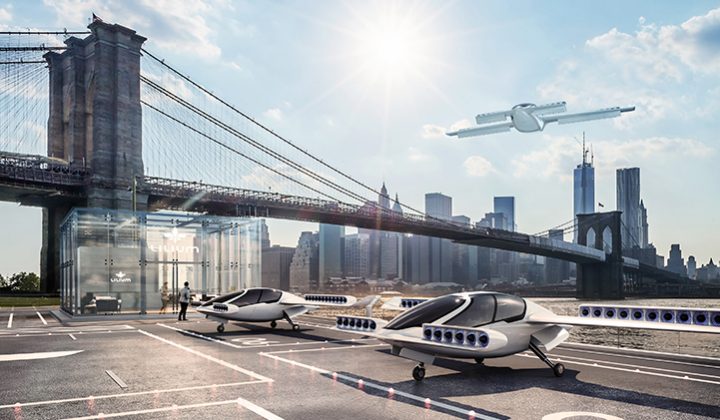When the film The Fifth Element came out in 1997, it depicted a city full of flying cars…in 2263. Actually, one may have to wait 2020 only for smart cities to put drone taxis into circulation in the air. Focus on five vehicles that may be flying in a near future.
Airbus, Uber, Intel… the race for flying cars and hybrid vehicles somewhere between cars, drones and planes has started: a first taxi drone has already been tested in the skies of Dubai.
Uber Elevate: the transportation network company’s autonomous vehicle
Uber’s flying car may carry four passengers. It is designed as autonomous and piloteless. Uber intends to use it as a transportation mean: both as a taxi service and a rideshare on demand.
The transportation company is really involved in this flying car project. Right now, Uber Elevate is nothing more than a concept, however its prototype is being developed and should be made public in the short term.
Uber held the “Elevate Summit” in May 2018 in Los Angeles, one of the very cities where the company plans on launching a flying taxi service in the years to come. Indeed, Uber announced that they would start the first trials in 2020 in Los Angeles and Dallas. Their goal: starting commercial service in 2023.
EHANG 184: up in the skies of Dubai
Designed by Chinese company Beijing Yi-Hang Creation Science & Technology, this vehicle equipped with eight propellers and four arms looks like a helicopter. It takes off and lands vertically.
The taxi drone has already flown with a passenger onboard. During its first flights, EHANG went up to 300 m and flew 15 minutes. So far, it has a 25 minute autonomy on average, at a 100km/h speed.
It should be in service in the Summer of 2018 in Dubai. Ehang flying cars are already used in China, for photography related missions mainly.
EHANG is building a single-seat quadcopter able to carry one passenger for city rides under 50 km.
Airbus Vahana: a prototype of flying car designed for private individuals
The specificity of this vertical take off and landing flying vehicle? It will be available for private individuals to purchase. Dimensions: a 6.2m wingspan, 5.7m long, 2.8 m high and a weight of 745kg upon take off.
This single-seat flying vehicle is pilotless. It has a 62 km autonomy and can fly up to 175 km/h.
Airbus Vahana performed flying tests in January 2018. The longest flight lasted 53 seconds, for a take off and landing only, nevertheless the performance is quite remarkable for a two-year old prototype.
Next step for Airbus: succeding in having the vehicle fly horizontally, which implies testing the transition process of the tipping engines. No doubt Airbus flying cars will make a name for themselves in the future…
Volocopter: CES 2018’s star
Designed in Germany, this vehicle developed by company e-volo takes off and lands vertically. It can carry two passengers and flies without a pilot. Thanks to its 18 electric rotors, it can fly up to 100km/h while remaining remarkably silent. Nine batteries enable Volocopter to fly up to 27 minutes at a speed of 50 to 70km/h. It is meant for smart cities and transportation companies.
Presented at the CES 2018, the drone flew statically and autonomously for a few minutes, a real success for the German company during the major event for tech innovation.
After successful trial flights, the team is now working on the integration and scaling of air taxi services in cities.
Lilium: holder of all records for flying cars
The Munich-based company aims to develop a new kind of individual transportation: it is working on the world’s first electrical VTOL (vertical take off and landing) vehicle.
With five passengers on board, Lilium holds the record of capacity. It actually needs a sixth person on board, for this ten-meter wingspan vehicle needs a pilot.
This flying car also holds the record for speed and autonomy, for it can fly up to 300km/h for 300km.
Lilium’s flying vehicle will carry people on demand. A first trial flight succeeded in 2017, with a smaller version of the VTOL vehicle.
Interested by urban mobility? Learn more about the New Energies major offered at ESILV, engineering school in Paris.











